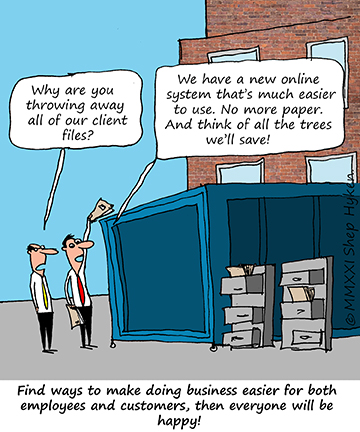Reducing friction is all about creating an easier experience for the customer. In my book, The Convenience Revolution, I identify six ways to create convenience.

The first, reducing friction, is tied to all five other principles. And, all of them focus on creating convenience and reducing friction for customers. But how about we look inside our organizations and the way we conduct business internally? Do we think about the friction we cause our employees? What extra work do they do because of antiquated systems and processes?
For our outside customers, when we reduce friction, they find it easier to do business with us. Internally, when we reduce friction for employees, we make it easier for them to do their jobs, which has a direct impact on the customer.
That brings me to an excellent article posted by Josh Linkner, innovation guru, who wrote about how tiny air bubbles led to a potential $28 billion cost savings. Noah Silberschmidt is the founder and CEO of Silverstream Technologies, a company that reduces friction – not for customers, but for large oceangoing ships that move people and cargo through the seas. Apparently, large ships going through water create a lot of friction and drag. Silverstream Technologies has an air lubrication system that reduces friction by blowing tiny bubbles, less than one millimeter in diameter, in front of the ship, creating an “air carpet” for the ship to ride on. This reduces fuel consumption by as much as 10%. If the 50,000 large oceangoing vessels in the sea used this technology, there would be approximately $28 billion in fuel cost savings. That’s a lot of money – and a lot of bubbles!
The point is this: We use convenience to create a better customer experience. We reduce friction by eliminating unnecessary effort. But, convenience and lower friction need to go beyond the customer experience. I really encourage you to look at the internal side of what you do. What friction can be eliminated for your employees, making it easier for them to do their jobs? What processes could be updated to save time and effort?
Freeing up employees from cumbersome processes, systems and operations has a positive impact on many levels. In some cases, it eliminates frustrating tasks. It can save time – and time is money! It makes employees more productive, and a byproduct of feeling productive is fulfillment. That means employees are happier, and subsequently more engaged in their jobs and with customers. And, happiness means less employee turnover.
So, your innovation may not be blasting bubbles into the ocean, but it has the same impact. It makes your company and employees more efficient and potentially saves you money. And, who doesn’t want that?



